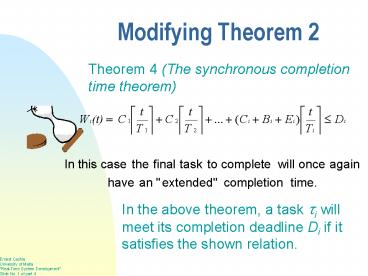Modifying Theorem 2 - PowerPoint PPT Presentation
Title:
Modifying Theorem 2
Description:
Modifying Theorem 2 Theorem 4 (The synchronous completion time theorem) In the above theorem, a task i will meet its completion deadline Di if it satisfies the shown ... – PowerPoint PPT presentation
Number of Views:71
Avg rating:3.0/5.0
Title: Modifying Theorem 2
1
Modifying Theorem 2
Theorem 4 (The synchronous completion time
theorem)
In the above theorem, a task ?i will meet its
completion deadline Di if it satisfies the shown
relation.
2
One Final Example(Taken from Software
Engineering Fundamentals by A. Behforooz)
- Consider the following 3 dependent and periodic
tasks - Task 1 C30 T100 D100 E0 B0
- Task 2 C70 T200 D200 E0 B30
- Task 3 C30 T200 D150 E50 B6
- Using theorem 3 ?1 30/100 0.3 ? schedulable
- ?1,?2 (30/100)(7030)/200 0.8 ? schedulable
- ?1,?2,?3 (30/100)(70/200)(30506)/200 1.08
? NOT schedulable - Using theorem 4 W3(t)t03070306 136 ms
- N1,1 1?(136-100)/100? 2
- ? t1 136(2-1)30 166 ms (beyond ?3 deadline)
- Changing task priority from (1-2-3) to (1-3-2)
results in - W3(t)t030307030 166 ms
3
Priority Inversion
- Meaning A lower priority task executing before
one with a higher priority
4
Timeline of previous slide
5
Expanded Portion of Previous Timeline
6
Modified and Augmented Portion from Previous Slide
?1 queued
?1 queued
7
A Solution to Priority Inversion
- Use of Priority Ceiling Protocol (PCP) which is
made up of 3 rules - Pre-emption rule
- Regular priority pre-emption
- Inheritance rule
- If a lower priority task blocks a higher
priority one, the lower inherits the priority of
the higher priority task - Priority ceiling rule
- A task cannot get at a shared resource if its
priority is less than any of the ceilings of the
shared resources currently locked by other tasks
8
Bad PCP usage Example
Assume tasks A, B, C, and D have priorities as A
highest and D lowest. The tasks use 2 server
tasks as follows S1 used by A and C S2 used by
tasks B and D.
9
McCabes R-T System Analysis
- Uses a modified interpretation of standard DFDs
- Transform ? Markov process state (a probabilistic
queuing model) - Data flow ? Transitions
- Therefore the following reasoning may be
applied - 0 lt pij 1.0
- (p transitional probability)
- True for each flow path
10
Example of McCabes R-T System Analysis
- Due to the lengthiness of this example it was
thought better to hand it out as an MS-Word97
document. Therefore, it is available online and
in hard-copy form separately. Please refer to it
while it is explained during lecture sessions.































